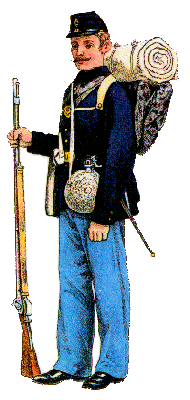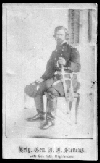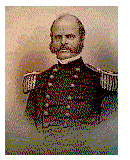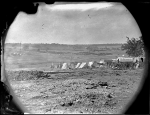"Thank God Lincoln had only one 79th Highlander
Regiment."
Charleston Mercury News... in its account of the Battle of Secessionville. "I have never seen regular troops that equaled the Highlanders in
soldierly bearing and appearance."
General Sherman...after the 79th participated in Second Bull Run.

History of the Highlanders :
 As the Bagpipes played, the 795 men of the 79th New York
Cameron Highlanders marched away to fight in the bloodiest war the United States would
ever engage in. Organized in 1859, the 79th Regiment of the New York State Militia was
comprised primarily of emigrant Scots and Scottish-Americans. The militia was modeled
after the famous Scottish regiment of the British Army, "The Cameron
Highlanders" as were the uniforms. Kilts in the "Cameron of Erracht"
tartan, black Glengarries with red-white-and blue dicing around the headband, and
red-trimmed navy-blue dress jackets were worn setting them apart from all other regiments.
A sporran, or "hairy purse" was worn around the waist and high socks with red
and white dicing rounded out this flashy uniform. As the war progressed, the demands of
battle warranted the shift to "Cameron of Erracht" tartan trousers, or
"trews" in place of kilts and blue Kepis in place of the Glengarries. After the
first battle of Bull Run the standard uniform of the Federal Army were worn. At right
is a Sergeant in original Full Dress, 79th Cameron Highlanders, circa. 1862. Wearing the
Cameron of Erracht Trews, or Cameron Plaid trousers. This uniform was worn in the early
part of the war and was used in replacement of the kilt by the Scottish members of the
Regiment. There seems to be alot of controversy regarding the timing of uniform changes. I
would guess that it was due to the fact that some soldiers changed various parts of the
uniform at different times. As the Bagpipes played, the 795 men of the 79th New York
Cameron Highlanders marched away to fight in the bloodiest war the United States would
ever engage in. Organized in 1859, the 79th Regiment of the New York State Militia was
comprised primarily of emigrant Scots and Scottish-Americans. The militia was modeled
after the famous Scottish regiment of the British Army, "The Cameron
Highlanders" as were the uniforms. Kilts in the "Cameron of Erracht"
tartan, black Glengarries with red-white-and blue dicing around the headband, and
red-trimmed navy-blue dress jackets were worn setting them apart from all other regiments.
A sporran, or "hairy purse" was worn around the waist and high socks with red
and white dicing rounded out this flashy uniform. As the war progressed, the demands of
battle warranted the shift to "Cameron of Erracht" tartan trousers, or
"trews" in place of kilts and blue Kepis in place of the Glengarries. After the
first battle of Bull Run the standard uniform of the Federal Army were worn. At right
is a Sergeant in original Full Dress, 79th Cameron Highlanders, circa. 1862. Wearing the
Cameron of Erracht Trews, or Cameron Plaid trousers. This uniform was worn in the early
part of the war and was used in replacement of the kilt by the Scottish members of the
Regiment. There seems to be alot of controversy regarding the timing of uniform changes. I
would guess that it was due to the fact that some soldiers changed various parts of the
uniform at different times.
The 79th Regiment Militia, failing to be ordered to the front
for three months, organized, under authority from the War Department, as volunteers at New
York city, where, commanded by Lieut.-Col. Samuel McKenzie Elliott, it was mustered in the
service of the United States for three years May 29, 1861. The men were recruited
principally in New York city; the regiment was turned over to the State in September,
1861, and received its numerical designation December 11, 1861. In January, 1864, members
of the 51st Infantry, and of the 45th, 50th and 100th Pa. Volunteers, were attached to the
regiment, serving with it about two months. May 4, 1864, Col. Samuel M Elliott received
authority to recruit a regiment, the Cameron Highlanders; this authority was modified to
recruit for this regiment. May 13, 1864, the men not entitled to be mustered out were
formed into two companies, A and B; those entitled to be mustered out at the expiration of
the term of service of the regiment proceeded to New York city and were there discharged,
under Lieut.-Col. John More, May 31, 1864. In November, 1864, the men enlisted by Colonel
Elliott joined the companies in the field as Companies C and D; in January, 1865, another
company, E, joined, and in March, 1865, Company F was organized in the field from recruits
received.
In July of 1861, the 79th was in position around Washington,
D.C., ready to battle the Rebels to the south. Then, Colonel William T. Sherman selected
the 79th to march with his brigade towards Manassas Junction, Va. to meet the
Confederates. The result was the First Battle of Bull Run, or Manassas. The 79th fought
well and acted as rear guard while the remaining beaten Federals retreated to Washington.
Colonel James Cameron, Commander of the 79th and brother of Union Secretary of War, Simon
Cameron was killed in the action. In August of 1861, the 79th was engaged in strengthening
the fortifications around Washington. Col. Isaac Ingalls Stevens was placed in charge of
the battered 79th to get them back into shape.
 With morale low, the
traditional uniform ordered replaced by standard Federal issue(as indicated at left), a
cancellation of a promised furlough and the appointment of a new commanding officer
(instead of an election) the 79th mutinied. When General McClellan got wind of the mutiny, he dispatched
Regular Army troops to Washington to surround the rebellious 79th with artillery. Col.
Stevens called upon the 79th. "You are soldiers, and it is duty to obey. I am your
colonel, and your obedience is due to me." As the Regulars filed around the 79th
preparing to fire into the ranks of the 79th, the mutiny came to an end. An order from
Gen. McClellan deprived the 79th of their colors. The flag was not to be returned to the
79th until they learned the first duty of a soldier is to obey and that they prove on the
field of battle that they are not wanting in courage. Col. Stevens drilled the 79th in all
aspects of a soldier's life with an unrelenting insistance on Regular Army dress and
deportment. After an impressive skirmish with the Confederates at Lewinville, Virginia,
Stevens arranged for the return of the 79th's colors. General McClellan made the
presentation in person telling the men that they had acquitted themselves as true
soldiers. Stevens had won the 79th's hearts and minds to the extent that when he was
promoted to Brigadier General, the 79th requested to be transfered with him to his new
command. They presented him with an ornate sword, sash and spurs. Colonel David Morrison,
former British officer in the famed 42nd Highland Infantry, the "Black
Watch" assumed command of the 79th. With morale low, the
traditional uniform ordered replaced by standard Federal issue(as indicated at left), a
cancellation of a promised furlough and the appointment of a new commanding officer
(instead of an election) the 79th mutinied. When General McClellan got wind of the mutiny, he dispatched
Regular Army troops to Washington to surround the rebellious 79th with artillery. Col.
Stevens called upon the 79th. "You are soldiers, and it is duty to obey. I am your
colonel, and your obedience is due to me." As the Regulars filed around the 79th
preparing to fire into the ranks of the 79th, the mutiny came to an end. An order from
Gen. McClellan deprived the 79th of their colors. The flag was not to be returned to the
79th until they learned the first duty of a soldier is to obey and that they prove on the
field of battle that they are not wanting in courage. Col. Stevens drilled the 79th in all
aspects of a soldier's life with an unrelenting insistance on Regular Army dress and
deportment. After an impressive skirmish with the Confederates at Lewinville, Virginia,
Stevens arranged for the return of the 79th's colors. General McClellan made the
presentation in person telling the men that they had acquitted themselves as true
soldiers. Stevens had won the 79th's hearts and minds to the extent that when he was
promoted to Brigadier General, the 79th requested to be transfered with him to his new
command. They presented him with an ornate sword, sash and spurs. Colonel David Morrison,
former British officer in the famed 42nd Highland Infantry, the "Black
Watch" assumed command of the 79th.
Steven's requested the Highlanders to accompany him on an
expedition aboard Du Pont's ships. McClellan protested but the 79th set sail with 12,000
other infantry units to Port Royal, South Carolina. The Confederates abandoned the Fort's
Walker, Beauregard and the earthworks after a gunnery duel with Du Pont's ships. The 79th
and other troops moved ashore and occupied the earthworks and the town of Beaufort. Port
Royal was a town full of dysentery and fever cases. Most of the Union infirmaries were
full of patients. The 79th, however, employed British camp sanitary practices resulting in
1 lonely patient in the hospital. The 79th spent the next 11 months skirmishing with
Johnny Reb's and burning properties of successionists and influential Rebel sympathizers.
Two dogs and an alligator were kept as pets. One of the dogs, named "Tip",
because of a missing leg, became the 79th's mascot and remained with the unit throughout
the war. Tip may have been responsible for Lt.Gen. Longstreet's defeat at Knoxville months
later. June of 1862 found the 79th part of a bungled Battle of Secessionville,
South Carolina. Brigadier Gen. Henry W. Benham was in temporary charge of the 79th's
brigade and one other. He ordered the 79th on a devastating and hopeless attack on the
fort. The approach to the fort was surrounded by swamp and defended by rifle pits,
trenches and obstacles. The 79th approached the fort behind the 8th Michigan Infantry, cut down by
devastating fire before reaching the works. The Highlander's were trapped. Promised
reinforcements never arrived and the 79th was forced to retreat back across the
treacherous grounds they had so bravely fought through to reach the fort. The Union attack
failed but the 79th was praised by the Confederate newspapers stating, "Thank God
Lincoln had only one 79th regiment." On July 8th, the 79th's brigade was transfered
back to Virginia. Sherman stated that he had never seen regular troops that equalled the
Highlanders in soldierly bearing and appearance. The 79th participated in Second Bull Run
in late August of 1862.
 At the Battle of Chantilly,
Virginia, on 1 September 1862, General Stevens (click on his image to enlarge, and read
his obituary.)took the flag of the 79th from the fifth flag bearer to fall, but this time
it was to lead them in a charge against Stonewall Jackson's troops. He shouted,
"Highlander's, my Highlander's, follow your general!" when he was struck by a
bullet to the head and killed instantly. After the war, the surviving 79th members sent
the ripped and bloodstained banner to Steven's widow with a note that read, "His
memory is engraven on the hearts of everyone of his Highlanders." At the Battle of Chantilly,
Virginia, on 1 September 1862, General Stevens (click on his image to enlarge, and read
his obituary.)took the flag of the 79th from the fifth flag bearer to fall, but this time
it was to lead them in a charge against Stonewall Jackson's troops. He shouted,
"Highlander's, my Highlander's, follow your general!" when he was struck by a
bullet to the head and killed instantly. After the war, the surviving 79th members sent
the ripped and bloodstained banner to Steven's widow with a note that read, "His
memory is engraven on the hearts of everyone of his Highlanders."
On September 17th, the 79th was to fight in the bloodiest day
in American history, Antietam
near Sharpsburg, Md. They fought the Confederates at Burnside's Bridge and at Sherrick's
farm. Amazing as it might seem, the 79th's total losses were only 40 casualties. The
79th's next engagement wasn't until July, 1863 when they arrived shortly after Vicksburg
had fallen. They were too late to fight and sent off to tear up railroad tracks near
Jackson, Mississippi. The Highlanders arrived in
Jackson only to find 150 sleeping Rebels Gen. Joe E. Johnston had left behind after he
abandoned the city. The 79th promptly captured the sleeping Rebels. The 79th marched to
join Major General Ambrose E. Burnside's (pictured at left) campaign in eastern Tennessee.
On 2 September, 1863, they took the key rail city of Knoxville. To defend the city from
Rebel assult, the Union troops built several forts and the 79th and others occupied an
existing fort, Fort Loudon. Learning of the attack early enough, preparations were made in
defense of the fort. General Longstreet had spied a Highlander walking a dog (probably Tip
and William Sam of Company B) directly into the fort. Not knowing that Tip and Private Sam
had walked on a plank, Longstreet assumed the fort was not guarded by a ditch. This
mistake was to cost the Rebs the battle. Longstreet attacked at dawn on the 29th of
November with three brigades. The 79th quickly poured water into the ditch, and while the
attack was still forming, the water froze. The Confederates charged the fort and the 79th
opened fire. Reaching the ditch, the Rebs began to slip and slide. The Highlanders threw
artillery shells with lit fuses into the ditch. The explosions ripped apart the attackers.
First Sergeant Francis
Judge leaped into the ditch yanked the 51st Georgia Infantry colors from the
flag-bearer and retreated back to the fort. He won the Medal of Honor for this. The Rebs
scrambled out of the ditch in retreat. The 79th shouted, "Remember James
Island", referring to their own failed attack at Seccessionville. 813 Rebels were
killed while only 9 casualties were suffered by the 79th. Longstreet gave up on Tennessee
and joined Gen. Lee's forces in Virginia. The 79th wintered in Tennessee and then moved to
Annapolis, Md. In the spring of 1864, they marched south to join Gen. Grant's Army of the
Potomac. For 26 days they marched to meet Grant through an area known as, "The
Wilderness". The Highlanders arrived in
Jackson only to find 150 sleeping Rebels Gen. Joe E. Johnston had left behind after he
abandoned the city. The 79th promptly captured the sleeping Rebels. The 79th marched to
join Major General Ambrose E. Burnside's (pictured at left) campaign in eastern Tennessee.
On 2 September, 1863, they took the key rail city of Knoxville. To defend the city from
Rebel assult, the Union troops built several forts and the 79th and others occupied an
existing fort, Fort Loudon. Learning of the attack early enough, preparations were made in
defense of the fort. General Longstreet had spied a Highlander walking a dog (probably Tip
and William Sam of Company B) directly into the fort. Not knowing that Tip and Private Sam
had walked on a plank, Longstreet assumed the fort was not guarded by a ditch. This
mistake was to cost the Rebs the battle. Longstreet attacked at dawn on the 29th of
November with three brigades. The 79th quickly poured water into the ditch, and while the
attack was still forming, the water froze. The Confederates charged the fort and the 79th
opened fire. Reaching the ditch, the Rebs began to slip and slide. The Highlanders threw
artillery shells with lit fuses into the ditch. The explosions ripped apart the attackers.
First Sergeant Francis
Judge leaped into the ditch yanked the 51st Georgia Infantry colors from the
flag-bearer and retreated back to the fort. He won the Medal of Honor for this. The Rebs
scrambled out of the ditch in retreat. The 79th shouted, "Remember James
Island", referring to their own failed attack at Seccessionville. 813 Rebels were
killed while only 9 casualties were suffered by the 79th. Longstreet gave up on Tennessee
and joined Gen. Lee's forces in Virginia. The 79th wintered in Tennessee and then moved to
Annapolis, Md. In the spring of 1864, they marched south to join Gen. Grant's Army of the
Potomac. For 26 days they marched to meet Grant through an area known as, "The
Wilderness".
 The 79th's last engagement was near Spotsylvania Court
House on May 8, 1864. They were to meet Longstreet one final time. The Highlanders moved
forward against veteran troops of Longstreet. They smashed fences and drove the enemy from
the field. Click on the image at left to see an original photo of the Spotssylvania
Battlefield. Col. Morrison was wounded and command of the 79th was passed to Col. Laing.
Eight days later, their three year enlistment up,the 79th marched back to New York with
only 120-130 of the original members left. They received a hero's welcome at Mercer House
and were mustered out of service. A few reenlisted, but the original Higlanders had seen
their last battle at Spottsylvania. The 79th's last engagement was near Spotsylvania Court
House on May 8, 1864. They were to meet Longstreet one final time. The Highlanders moved
forward against veteran troops of Longstreet. They smashed fences and drove the enemy from
the field. Click on the image at left to see an original photo of the Spotssylvania
Battlefield. Col. Morrison was wounded and command of the 79th was passed to Col. Laing.
Eight days later, their three year enlistment up,the 79th marched back to New York with
only 120-130 of the original members left. They received a hero's welcome at Mercer House
and were mustered out of service. A few reenlisted, but the original Higlanders had seen
their last battle at Spottsylvania.

Sources:
The Union Army A History of Military Affairs in the Loyal States 1861-65 -- Records of the
Regiments in the Union Army -- Cyclopedia of Battles -- Memoirs of Commanders and
Soldiers. 8 vols. Madison: Federal Publishing, 1908.
"Yankees in Kilts",Mark W. McKnight, Civil War Times, December 1996 Ed.
"The Seventy-ninth Highlanders, New York Volunteers in the War of the
Rebellion, 1861-1865", Willaim Todd, 1886.
|
